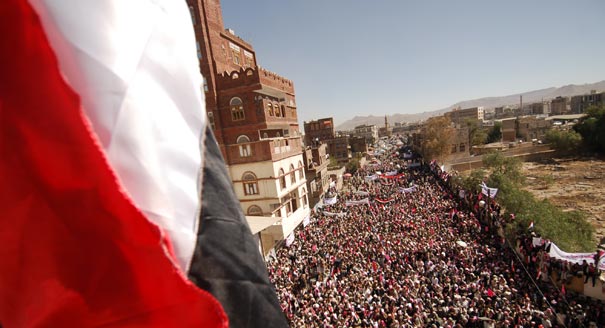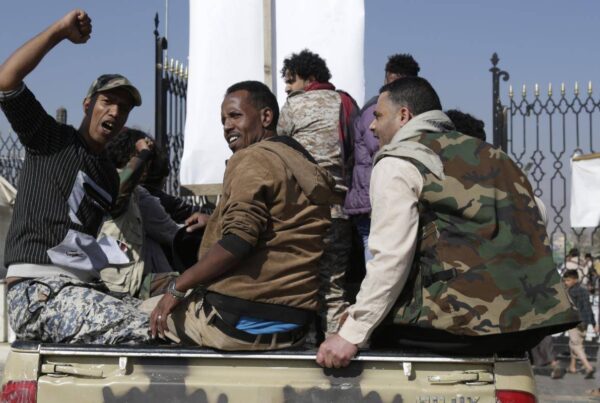The success of the UN-brokered transition process in Yemen has fallen into serious question following Hadi’s ousting and the Houthi take-over of Sanaa.
For three years, Yemen has been touted as a successful model of international intervention to contain the crisis triggered by the Arab Spring—at least according to the United Nations, various UN Security Council ambassadors, and, most importantly, the UN special adviser on Yemen, Jamal Benomar, who today announced his resignation after four years in the job.
But the deteriorating situation of the country, particularly after President Abd-Rabu Mansour Hadi was ousted by the Zaidi Shia Islamist rebels known as the Houthis in mid-January 2015, has put an end to this rhetoric. And since March 25, when a Saudi-led coalition of Arab and other states launched a military intervention, the situation has worsened considerably.
Jamal Benomar’s Role and Legacy
When Jamal Benomar assumed his position as special envoy in April 2011, Yemen’s then-president, Ali Abdullah Saleh, knew that he could not hold out for long against the many opposition currents that had converged to overthrow him. This simplified the task of the UN envoy, who—along with Saudi Arabia and other Gulf states—brokered the implementation of the so-called Gulf Initiative, according to which Saleh would resign and hand power to Hadi, his vice president, in a managed transition. After months of negotiations and despite the intensification of violence, Hadi was finally able to accede to the presidency in February 2012 with considerable international and Yemeni support as part of a transitional process that was not to exceed two years.
The Moroccan-born Benomar’s ability to speak Arabic allowed him to address Yemeni politicians directly, avoiding the linguistic obstacles that foreign ambassadors often face in Yemen. His linguistic abilities also helped him win struggles for influence with other diplomats, such as the U.S. Ambassador, in Yemen. The fact that Yemen was less complex than countries such as Syria or Libya, with a local conflict that could still be contained and had only limited foreign involvement, also strengthened the hand of the UN envoy, who had a number of opportunities to propel a full transition process in Yemen.
However, Benomar’s dominant position also meant that much hinged on his performance. It was difficult for one person to effectively manage all the parallel tracks of peacemaking in and around Yemen. Benomar’s continuous replacement of his small staff of aides did nothing to help the situation; in three years, his team was changed at least three times. The result was an increasing lack of coordination between Benomar’s office and the offices of other diplomatic missions in Yemen and even with other United Nations bodies. Benomar’s monopoly of power thus led to the absence of an integrated international policy, and when the UN envoy did not lead, the process quickly stagnated.
For example, one of the main reasons that the September 2014 Peace and National Partnership Agreement between the Houthis and Hadi’s government collapsed earlier this year was because the UN envoy’s office focused almost exclusively on implementing one of its components: the creation of a joint committee outlined in Article 16 that was to continue negotiations. The office did not consult with local and international signatories or supervisors, allowing Benomar to maintain control over the process. But because he was abroad most of the winter, there was little progress during the crucial months following the agreement. Many Yemeni leaders also complained that they did not know the content of the agreement until it was presented for signing. For days, Benomar had negotiated the agreement with the Houthi rebel leader Abdul-Malik al-Houthi without anyone else knowing its details.
The turn to war and international intervention in Yemen is a consequence of the failures of the Yemeni model. By sponsoring negotiations between the Houthis and other political parties after the Houthis placed Hadi under house arrest and declared their own constitution this January, Benomar recognized the reality imposed by the Houthis and sounded the death knell of the transition process.
The Collapse of the Yemeni Model
Of course the situation in Yemen is not only due to the UN envoy’s efforts, or lack thereof. Many overlapping local, regional, and international issues have contributed to the collapse of the political process, including the Saudi-Iranian conflict and the regional struggle to support or oppose the Muslim Brotherhood.
Ultimately, the failure is also linked to the original 2011 Gulf Initiative and its concept of a gradual compromise solution to Yemen’s crisis. The Gulf Initiative granted Saleh and his associates immunity from any legal prosecution, and it shied away from addressing human rights abuses committed during the uprising of 2011. It also did not stipulate that Saleh must abandon politics in return. Even though Saleh reluctantly surrendered the presidency in 2012, the former Yemeni leader remains highly active, having facilitated the Houthi expansion into Sanaa in 2014 to help orchestrate the overthrow of Hadi in 2015.
The Yemeni model also failed to take into account that dealing with a state like Yemen, which is economically weak and exposed to severe security threats, requires improving state institutions and supporting the country’s economy in order to produce a palpable difference for its citizens. Instead, frustrated Yemenis continued to fall prey to political polarization and the recruitment efforts of armed groups like the Houthis or al-Qaeda in the Arabian Peninsula (AQAP).
Considering the delicate political process the country was going through, the road map should have been more realistic than the one laid out by the Gulf Initiative. Its obsession with time had adverse effects as it prescribed the holding of a National Dialogue Conference in January 2014 without any real preparation. This led, tragically, to a discussion about the shape of the political system even before immediate grievances were addressed. In particular, the time schedule envisioned by the Gulf Initiative led to a speeding through of the draft constitution, the division of provinces in just two weeks, and an attempt to impose the constitution before putting it to referendum. All of this created a state of local public anger, which the Houthis used to their advantage when they overtook Sanaa in September 2014.
Necessary Changes to the UN’s Involvement
For any conflict resolution model to succeed, it must avoid falling under the pressure of time, and it must not discuss political and administrative issues before resolving immediate problems. It must also recognize the need to disarm nonstate actors on all sides of the conflict.
In view of the lack of coordination between the states sponsoring the Gulf Initiative and Benomar’s office, as well as between Benomar and the UN itself, and given the UN’s poor image in Yemen at the moment, the UN should seize the opportunity presented by Benomar’s resignation to redistribute his powers among a number of international diplomatic bodies. Whoever replaces Benomar, the work in Yemen cannot be done by one office alone.
As the experience in Yemen proves, no conflict resolution model will be able to achieve peace on the ground unless it is accompanied by skilled political leadership and a real international commitment to addressing the economic crisis. Supporting the newly appointed vice president, Khaled Bahah, could be one way to slowly empower a new leadership and to take over from Hadi, who failed to effectively lead the transition over the last two years.
But most importantly, Yemen must not be allowed to turn into an arena for regional conflicts, like Syria today or Lebanon before it. Military action alone is not going to bring peace to Yemen and the Saudi-led intervention cannot completely eliminate Saleh or the Houthis without destroying the country.
Possibly, however, Yemen could be the first fruit of the Iranian nuclear deal, if it gives the United States freer hands to engage with Iran—the Houthis’ main backer—whether through pressure or diplomacy. Yemen may then become the first real achievement of a new regional order represented by the emerging alignment of Turkey, Egypt, and Saudi Arabia.








